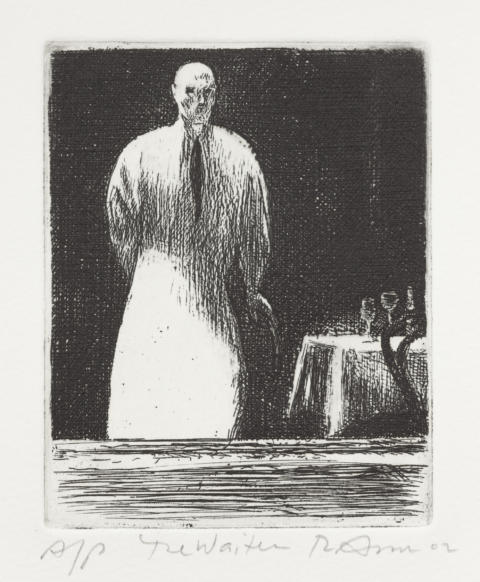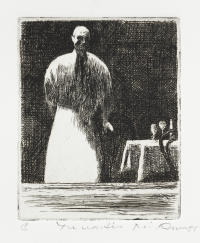
Etching. A man in a waiter’s apron stands left of centre, his left hand gripping the back of a bentwood chair. He is bald and wears a white shirt and dark tie with his apron. His facial features are summarily etched and his mouth is barely suggested. In front of him is a low wall. At the lower right is a covered table on which there are two wine glasses. There is a second chair, partly visible, in front of the table. The background is dark. There are two variant impressions of this state.
The plate has again been burnished in places, including the man’s face, his right shoulder, parts of the tablecloth, and a narrow area around it. There is also a vertical streak of light at the upper right.
The background has been cross-hatched with etching and is now a deep black. The man’s tie has been made darker. There are two variant impressions of this state.
- Catalogue Number
- E.104
- Title and Date
- The waiter
1996; reworked 2002
- Description of Featured Image
- A man in a waiter’s apron stands left of centre, his left hand gripping the back of a bentwood chair. He is bald and wears a white shirt and dark tie with his apron. In front of him is a low wall. At the lower right is a covered table on which there are two wine glasses. There is a second chair, partly visible, in front of the table. The background is dark.
- Where Made
- Alphington, Melbourne
- Medium Category and Technique
- Intaglio Print: Etching and burnishing on copper
- Support
- Wove paper. Identified papers: BFK Rives paper with watermark: ‘BFK RIVES / FRANCE’ with infinity symbol; Magnani paper with watermark: Romanesque ‘M’ with cross above; Arches paper with watermark: ‘ARCHES / FRANCE’ with infinity symbol.
- Dimensions
-
Image size: 113 x 89 mm
Matrix size: 113 x 90 mm - Artist’s Record Number
- RAE.111 (1996), RAE.145 (2002)
- Printer(s) and Workshop(s)
- States I and II, first edition (there are no impressions of state III other than those that constitute the edition), and state IV, printed by Rick Amor in his Alphington studio. State V printed by Amor in the Alphington studio (V.a) and by Martin King at the Australian Print Workshop, Fitzroy (Melbourne) (V.b). Second and third editions printed by Martin King at the APW.
- Summary Edition Information
- Five states. Three editions. First edition: edition of ten numbered impressions, 1996. Second edition: edition of ten numbered impressions, 2002. Third edition: edition of twenty numbered impressions, 2005.
- Exhibitions
- Niagara Galleries at IWOP 1997: Niagara Galleries at the International Works on Paper Fair, Mitchell Galleries, State Library of New South Wales, Sydney, 17–20 July 1997, no. 5.
- Literature
- For an account of the subject of the waiter in Amor’s art, see Gary Catalano, The Solitary Watcher: Rick Amor and His Art, Melbourne University Press, Carlton South, Victoria, 2001, p. 145.
- David Hansen, ‘Vacant Possession’, in Linda Short (ed.), Rick Amor: A Single Mind (exh. cat.), Heide Museum of Modern Art, Bulleen, Victoria, 2008, pp. 104–5.
- Collections
- State Library of Victoria, Melbourne: three state impressions, numbered 1 through 3, all dated 1996; ed. 10/10, dated 1996; two state impressions, numbered 2-1, 2-2, both dated 2002.
- National Gallery of Australia, Canberra: ed. 8/10, dated 1996 (2007.725); ed. 10/10, dated 2002 (2007.724); APW workshop proof 2/2, dated 2002 (2002.431.1218).
- Comment
This etching is one of a group of closely related works that also includes drawings, paintings and lithographs. The image in all of these works may be traced back to a newspaper photograph of three waiters, by John Woudstra, published in Melbourne’s Age newspaper in 1995. However, Amor’s various versions of the subject completely transform it and distance it from its origins, presenting what Gary Catalano describes as ‘portraits of contemporary urban humanity in all its fabled anonymity’ (Catalano 2001).
In E.104, the shroud-like whiteness of the waiter’s shirt and apron matches that of his blank, almost featureless, face, as he stands, solitary, separated from the viewer by the low wall in the foreground of the composition. The image is imbued with the strange sense that it contains an unexplained narrative, a quality in Amor’s work that has been linked to the cinema and, in particular, to cinematic stills (Hansen in Short 2008).
The waiter first appeared in Amor’s art in a small oil painted in 1995. A charcoal drawing and several further paintings followed and in all of these versions the waiter stands to the left of the table. The present etching is the first appearance of the waiter subject in a print. The motif occurs again in two lithographs: a large work of 1997 and a version made in 2012.
- Keywords
- Figure – male, Male figure, Man, Solitary male
- URL
- https://catalogue.rickamor.com.au/works/intaglio/the-waiter/
Record last updated 16/02/2021




